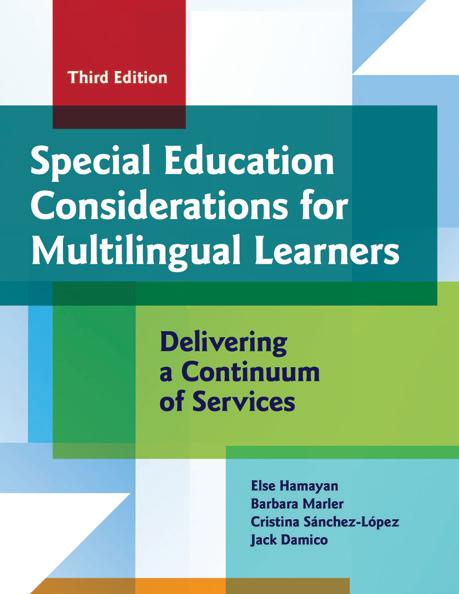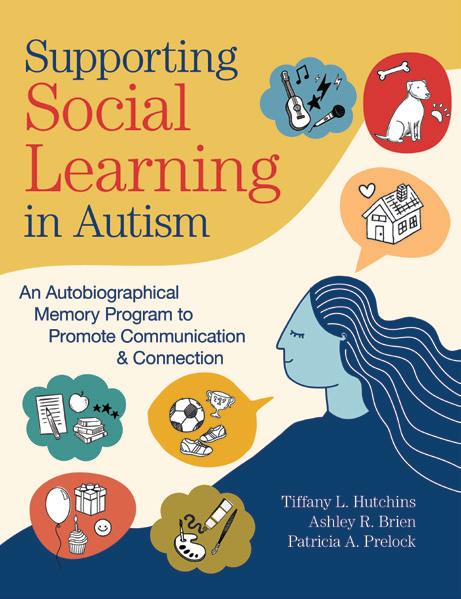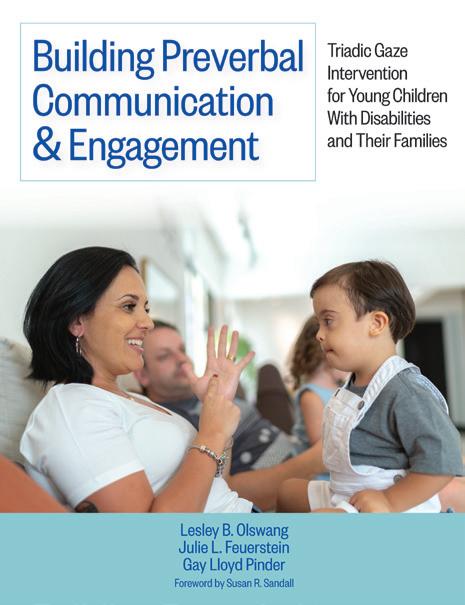TEXT







Prepare SLPs and educators to support the growing population of dual language learners with the third edition of this bestselling textbook, developed by three influential experts on bilingual language development and aligned with Head Start guidelines on cultural and linguistic responsiveness.
Updated with the latest research and recommended practices, this book gives a broad audience of future professionals the clear and comprehensive information they need to promote positive outcomes for young dual language learners and make informed decisions about assessment and intervention when a disorder is present. Readers will get up-to-date guidance on a wide range of key topics, including recognizing the typical stages of second language learning, supporting development in both languages, distinguishing a language delay from a disorder, planning culturally appropriate interventions, addressing reading disorders in bilingual children, and more. New and enhanced student-friendly features make this edition even more engaging and practical, and a robust new package of online support materials will help faculty members use the book effectively in their courses.
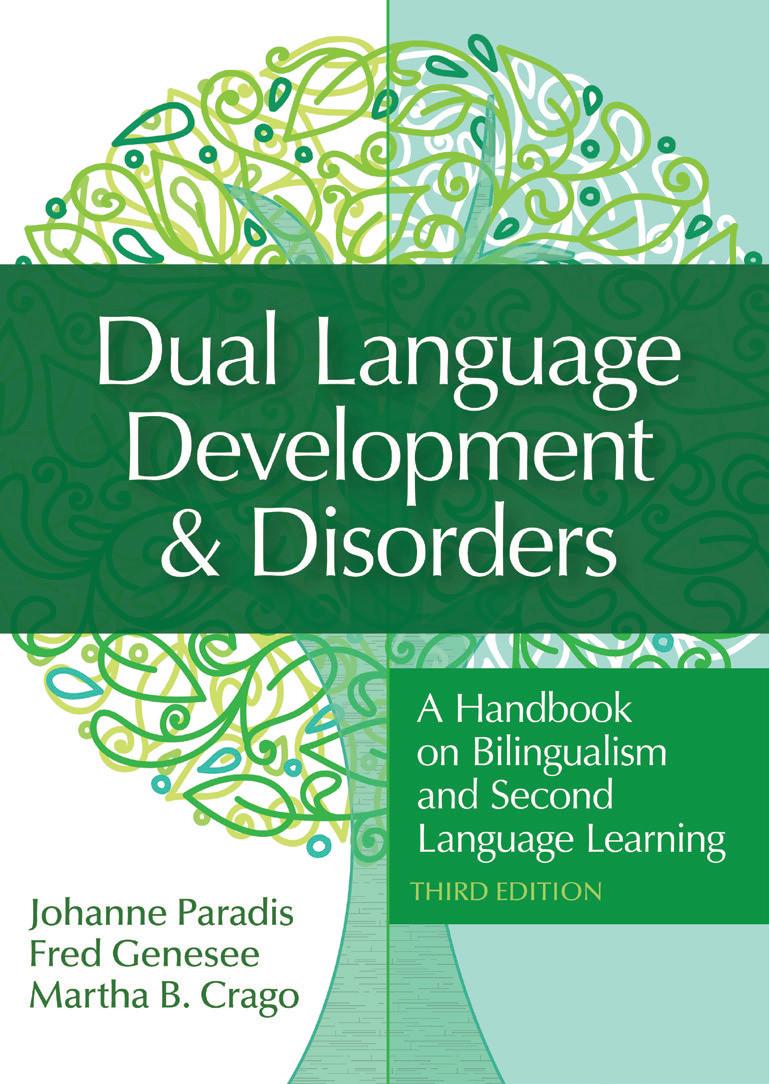
With the foundational knowledge in this state-of-the-art textbook—also a valuable resource for in-practice SLPs and educators—professionals will be ready to help young dual language learners thrive, both at home and in the classroom.

New chapter on supporting heritage language development in children with immigration backgrounds
updates throughout the book on best practices and

including learning
tables and figures
from
illustrate
Field
working with culturally and linguistically
class
Dual language learners are the fastest-growing segment of the U.S. student population, and the majority speak Spanish as a first lan guage. This graduate-level textbook—now in its third edition—gives future speech-language pathologists the comprehensive knowledge they need to work effectively with Spanish–English bilingual children and support their language development.
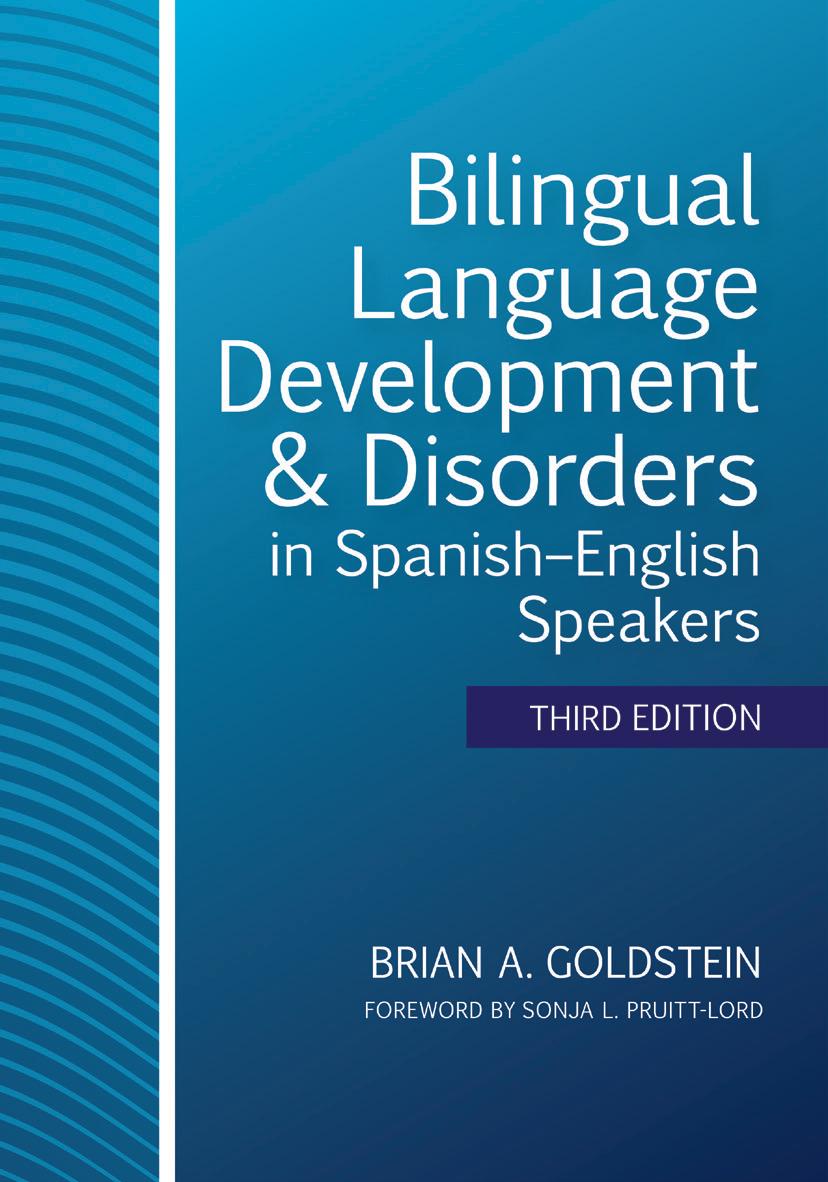
Aligned with current best practices and updated with the latest research and new chapters on critical topics, this book prepares SLPs for practice with cutting-edge information on language development and disorders of Spanish–English bilingual children. More than 25 leading researchers compile the high-level knowledge SLPs need to understand the complexity of language development in bilingual chil dren, distinguish language differences from disorders accurately, and conduct effective assessment and intervention. An essential graduate text that will also be a trusted reference for practicing professionals, this third edition gives current and future SLPs a broad, deep, and nu anced understanding of communication development and disorders in Spanish–English bilingual children.
NEW CHAPTERS ON: the human right to communicate in more than one language • development of speech perception and production in bilingual preverbal infants • culturally and linguistically responsive approaches to language intervention


UPDATED INFORMATION ON: bilingual language development of English learners • bilingualism and the child socialization process ▪ bilingual lexical development, assessment, and intervention • se mantic development • grammatical impairments • morphosyntactic development • cross-linguistic influence and code-switching
oral narrative language skills and disorders
The Human Right to Communicate in More Than One Language
Bilingual Language Development of English Learners
Bilingual Language Acquisition and the Child Social ization Process
Development of Speech Perception and Production in Bilingual Preverbal Infants
Cross-Linguistic Influence and Code-Switching
Bilingual Lexical Development, Assessment, and Intervention
Semantic Development in Spanish–English Bilinguals
Morphosyntactic Development
Spanish Child Heritage Speakers
Grammatical Impairments in Spanish–English Bilin gual Children
The Development of Oral Narrative Language Skills and Disorders in Spanish-English Bilingual Children
Literacy
Language and the Educational Setting
Speech Sound Development and Disorders
Fluency
Culturally and Linguistically Responsive Approaches to Language Intervention
literacy learning
the intersection of language and academics
first language loss and attri tion
speech sound development and disorders
fluency
professional development practices
Professional Development Practices and Content for Professionals Working with Preschool Dual Language Learners

More than 5 million English learners attend U.S. public schools—and yet fewer than 3% of teachers are certified to work with them.* Fill that gap in teacher education with this comprehensive textbook, an evidence-based guide to providing English learners in Pre-K–Grade 6 with explicit, systematic instruction on language and literacy fundamentals.
Aligned with IDA’s Knowledge and Practice Standards, this book prepares current and future educators to teach English learners the key components on language and literacy, as described in the Report of the National Literacy Panel for Language Minority Children and Youth. For each component, teachers will get a dedicated chapter with research-based insights on how to teach English learners, guidance on making connections across languages when teaching that component, and ready-to-use principles and strategies for instruction. Learning objectives, study questions, and extended application activities help educators grow their knowledge and apply it in their classrooms.
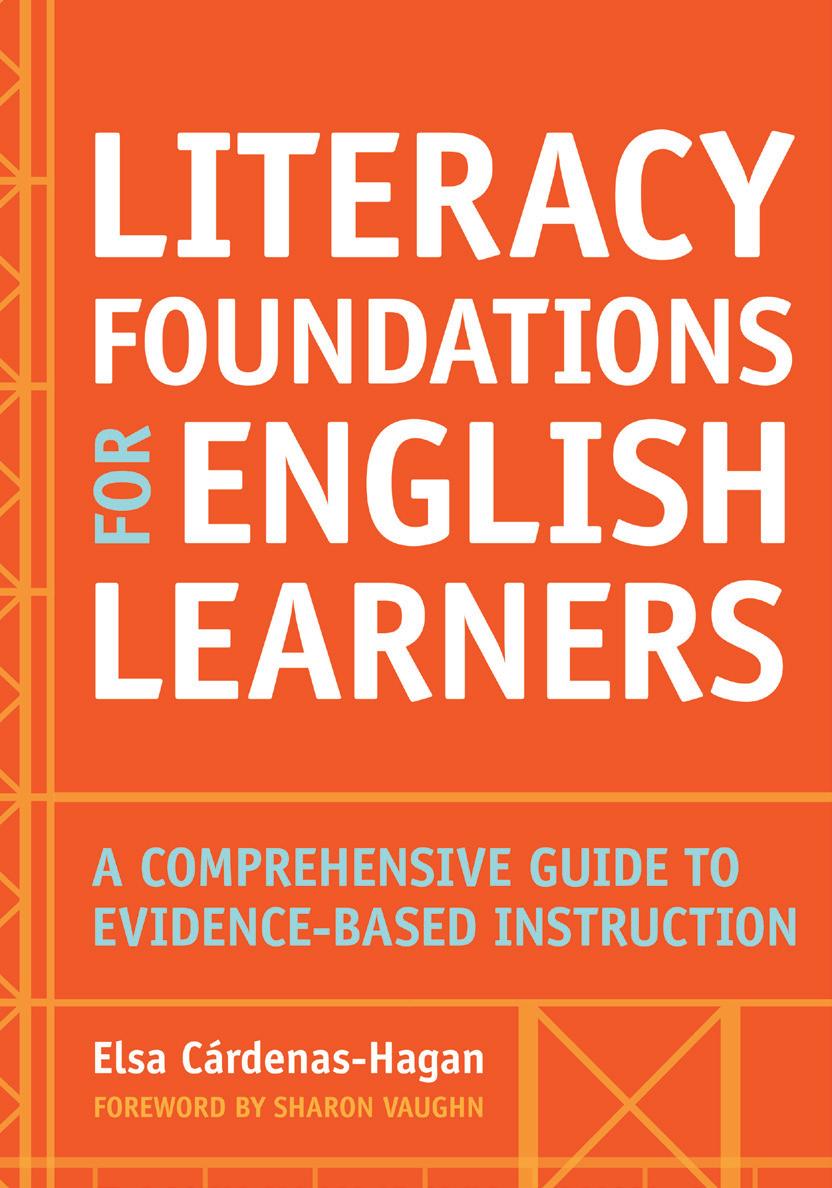

• Enter their classroom with a full understanding of the language and literacy development of English learners
• Teach English learners key components of language and literacy: phonological awareness, phonics, vocabulary, fluency, comprehension, spelling, and writing skills
• Apply insights from current, reliable research on how best to teach English learners
Use specific, evidence-based principles, strategies, activities, and sample teacher–student dialogues to guide and strengthen instruction
technology to adapt and enhance instruction for English learners
ONLINE COMPANION MATERIALS INCLUDED: Faculty will get helpful PowerPoint slides for each chapter, plus a sample syllabus that shows how to use this book in your course.

Multilingual learners in Grades K–12 are often overidentified or under identified for special education. The third edition of this groundbreak ing text offers a better way to meet the needs of multilingual learn ers: by creating a culturally and linguistically responsive multi-tiered system of support (MTSS) and implementing a continuum of services that meets the needs of the whole child.
Shifting away from traditional ways that schools address the needs of students who experience challenges, the new edition of this text takes a strengths-based approach to supporting multilingual students and focuses on the complex issues that affect a multilingual learner’s development. Chapters have been fully updated to reflect the latest best practices and reorganized to better align with MTSS. Educators and other school-based professionals will be fully prepared to:
• Form collaborative MTSS teams that blend the diverse expertise of staff members
• Evaluate and enhance the learning environment for multilingual learners
• Gather extensive data about six critical factors in students’ home and school life, from previous schooling experiences to cross-cultur al factors
• Authentically assess the strengths of multilingual learners
Create a continuum of services that addresses the individual needs of each student, including those experiencing challenges at school
effective instruction and intervention using a multilingual
Monitor the effectiveness of support strategies and programming for multilingual learners

PRACTICAL FEATURES: MTSS team activities to support professional learning
Templates, a rating scale,

other
A Framework for Considering the Special Needs of Multilingual Learners
A Collaborative Model of Information Gathering and Service Provision
The Learning Environment Created for Multilingual Learners
Personal and Family Factors
Physical and Psychological Factors
Previous Schooling Factors
Oral Language and Literacy Development
Academic Performance
Cross-Cultural Factors
Describing Before Identifying: When Specific Chal lenges Persist for Some Multilingual Learners
Delivering a Continuum of Services
Putting It All Together
Discussion questions to help teams apply the concepts to their own student
examples from the field
Aligned with national and state English language proficiency standards and assessments, this user-friendly guide shows elementary and secondary educators how to dif ferentiate core content-area instruction and assessment for the ELLs in their classes. Teachers will get concrete strategies they can use in any content-area classroom to engage every ELL, from beginning to advanced levels of English language development. The authors also highlight how teachers can address critical differences between ELLs with a strong foundation in the home language as well as students with limited or interrupted formal education.

SPECIAL FEATURES include true-to-life scenarios that ground every chapter, easy-to-use templates that model how to differentiate instructional units and lessons, and end-of-chapter professional development activities.
$48.95 | Stock #: 00380 | 2019 | 304 pages | paperback | ISBN 978-1-93400038-0
In this practical professional development guide, teachers, administrators, and leadership teams will learn about the powerful notion of the Bridge: the instructional moment when educators purposefully bring two languages together. Compatible with literacy programs used in K–12 schools today, the biliteracy unit framework in this book helps strategically guide bilingual learners to:

• Transfer the academic content they have learned in one language to the other
• Engage in contrastive analysis
• Develop academic English and Spanish across the content areas
• Read and write grade-level texts across the curriculum

• Develop metalinguistic awareness
$39.95 | Stock #: 00090 | 2013 | 192 pages | paperback | ISBN 978-1-93400009-0
By Ofelia García, Ph.D., Susan Ibarra Johnson, Ph.D., & Kate Seltzer, Ph.D.
Translanguaging refers to the dynamic language practices of bilinguals, as well as an instructional approach that teachers can use to support the academic and socioemotional success of bilingual students. Using examples from three very different classrooms, this book illustrates how translanguaging can level the playing field for bilingual students in English-medium and bilingual classrooms. Educators will learn how to use translanguaging for instruction and assessment to meet and exceed content and language development standards in their classrooms.

SPECIAL FEATURES include learning objectives, vignettes to illustrate pedagogical strategies, sample translanguaging unit designs, tools for teacher planning and evaluation, and end-of-chapter activities to help teachers apply what they learn to their own classrooms
$39.95 | Stock #: 00199 | 2016 | 224 pages | paperback | ISBN 978-1-93400019-9
Literacy Squared in Action
By Kathy Escamilla, Ph.D., Susan Hopewell, Ph.D., Sandra Butvilofsky, Ph.D., Wendy Sparrow, Ph.D., Lucinda Soltero-González, Ph.D., & Manuel Escamilla, Ph.D.
Discover how to plan, implement, monitor, and strengthen biliteracy instruction that builds on students’ linguistic resources in two languages, beginning in kindergarten. Teachers, ad ministrators, and leadership teams will learn to develop holistic biliteracy instruction units, lesson plans, and as sessments that place Spanish and English side by side.
SPECIAL FEATURES include key terms and/or guiding questions for every chapter; sample instruction units, lesson plans, student writing in Spanish and English, and paired writing rubrics; empirical evidence of students’ reading and writing development in Spanish and Eng lish; and questions for reflection and action at the end of each chapter.
$37.95 | Stock #: 00137 | 2014 | 224 pages | paperback | ISBN 978-1-93400013-7
Designed for teachers who dedicate their work to bilingualism, biliteracy, and equity for bilingual learners, this groundbreaking book is written in Spanish (not translated from English). Each chapter uses the Preview (English)—View (Spanish)—Review structure, using English for a brief preview and review and Spanish for the bulk of the content, to support bilingual teachers with a wide range of expertise in oral and written Spanish and English.

Preservice and inservice teachers will learn how to de velop, implement, and monitor interdisciplinary biliteracy units of instruction that they can use in any type of bilin gual program. As they use this book, they’ll also get op portunities to leverage their own bilingual resources and cultural funds of knowledge to strengthen their academic Spanish and biliteracy.
$39.95 | Stock #: 00434 | 2021 | 288 pages | paperback | ISBN 978-1-934000-43-4
Systematic cognate instruction can help young bilin gual learners master the vocabulary words and literacy skills they need for academic success. This is the first comprehensive guide on seamlessly working cognate instruction into existing lesson plans. Elementary school educators (K-6) will discover how to conduct engaging picture book read-alouds to incorporate cognates into vocabulary lessons, design customized cognate lesson plans, create content-area thematic units that include cognate words, and more. To help teachers quickly in tegrate cognate instruction into their curriculum, they’ll also get access to the Cognate Companion website, a database where they can find picture books and all their cognates and get 250+ ready-to-use cognate lesson plans for select picture books.

Language is a key tool for teach ing math—and using that tool effectively is especially important for multilingual learners and other diverse students who may need more support to access academic math language. In this practical book, middle and high school educators will learn how to effectively harness language to ensure math success for all students. Teachers will discover the concepts behind a language awareness ap proach, see the approach in action in different classroom contexts, get guidance on math lesson planning and implementation, and learn ways to reflect on their own practice to make a difference for diverse learners.

SPECIAL FEATURES include objectives, transcripts of math classroom discourse, Try It Yourself boxes, and ac tivities. Online materials include a lesson plan template, sample lesson plan, transcription guide, and more.
$39.95 | Stock #: 56313 | November 2022 | approx. 196 pages | 8 ½ x 11 | paperback | ISBN 978-1-68125-631-3
This book is the result of a 20-year collaboration between a school principal (Raymond R. Isola) and an educational researcher (Jim Cummins). Together, they document how the Sanchez Elementary School successfully implemented evidencebased instruction to transform the learning experiences of students from a low-income and linguistically diverse community in the Mission District of San Francisco.
The Sanchez School story shows the dramatic positive impact of using shared leadership and the resultsoriented cycle of inquiry to implement school-based policies designed to activate students’ talents and intellectual power within the classroom. Readers will be inspired to see the possibilities for linguistically and culturally diverse students from low-income communities, and they’ll reflect on their own school’s improvement strategies.
$39.95 | Stock #: 00410 | 2020 | 216 pages | paperback | ISBN 978-1-93400041-0

This book is a comprehensive foundational text on ELL education, ideal for pre-service elementary and secondary teachers, educational leaders, and literacy, special education, English as a second language (ESL), and bilingual specialists. Practical features include guiding questions, key terms, vignettes, teaching strategies, samples of student work, chapter review activities, discussion questions, research and activities, recommended readings.
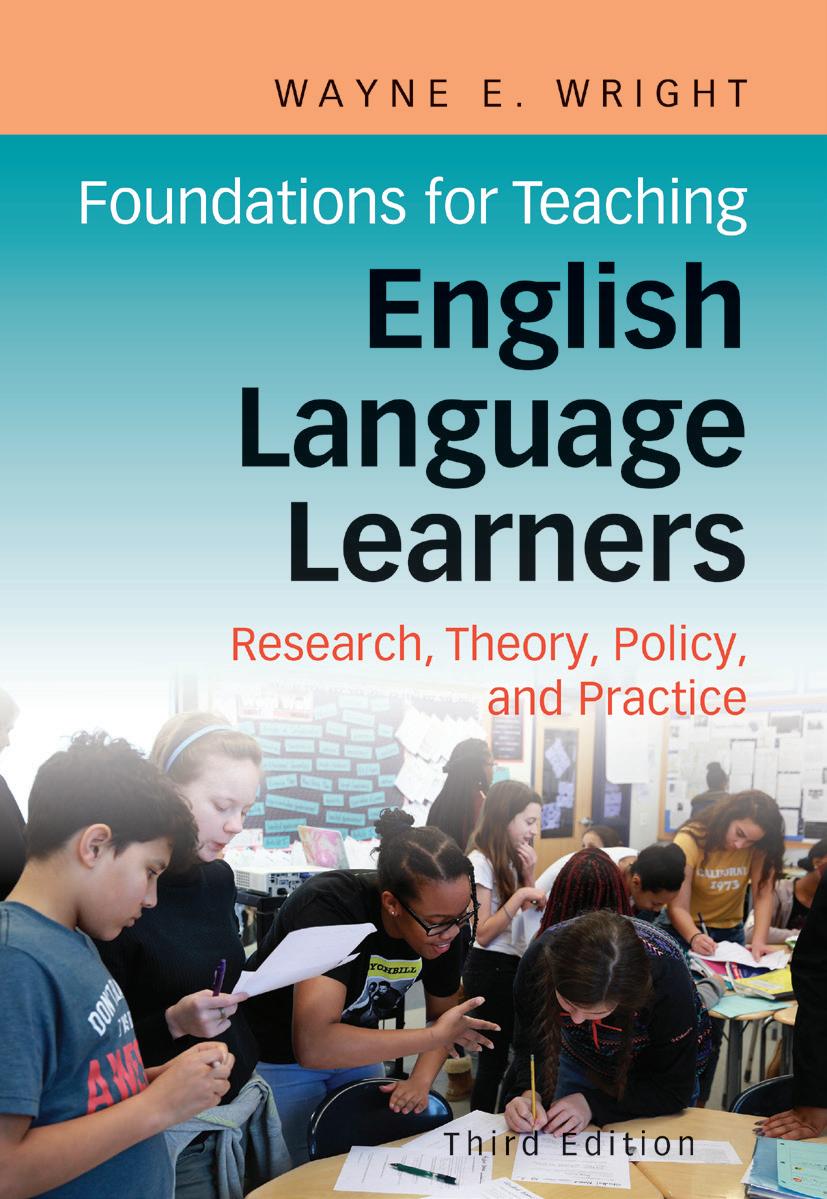
• Make research-based decisions on ELL policies, programs, practices, and assessment
• Meet state competency requirements in ELL education.

• Differentiate core content-area instruction for multilingual learners, including ELLs
• Teach oral language, reading, and writing in all content areas
• Use students’ home languages and technology as resources for learning
• Stronger multilingual perspective on ELL education, with attention to new research, theory, and practice on dynamic bilingualism and translanguaging
• New regulations, accountability requirements, and flexibility regarding ELLs since the reauthorization of ESSA
Greater focus on the complex language and literacy demands of the Next Generation Science Standards and other content-area standards—not just for ELLs, but for all students
New research on ELLs in content-area classes from the National Academies of Sciences, Engineering, and Medicine
The integration of new principles by Teachers of English to Speakers
Other Languages (TESOL, 2018) for the exemplary
WEBSITE INCLUDED: This book includes an interac tive
with extensive resources for students and
appreciate the Professor Control Panel on the

includes slide presentations for each chapter, a sample course syllabus,
more.
Many children with disabilities and their families struggle to con nect early in life and need support developing early communication skills—and now there’s a comprehensive text to prepare birth-to-three practitioners to deliver that critical support to young children with dis abilities and their families.
This accessible textbook will help professionals harness the power of Triadic Gaze Intervention (TGI), an evidence-based strategy that sup ports the development of early communication behaviors—gaze, ges tures, and vocalizations—in young children with disabilities. Through a straightforward protocol, practitioners will learn powerful techniques for helping caregivers engage young children during everyday rou tines and build their preverbal communication skills.
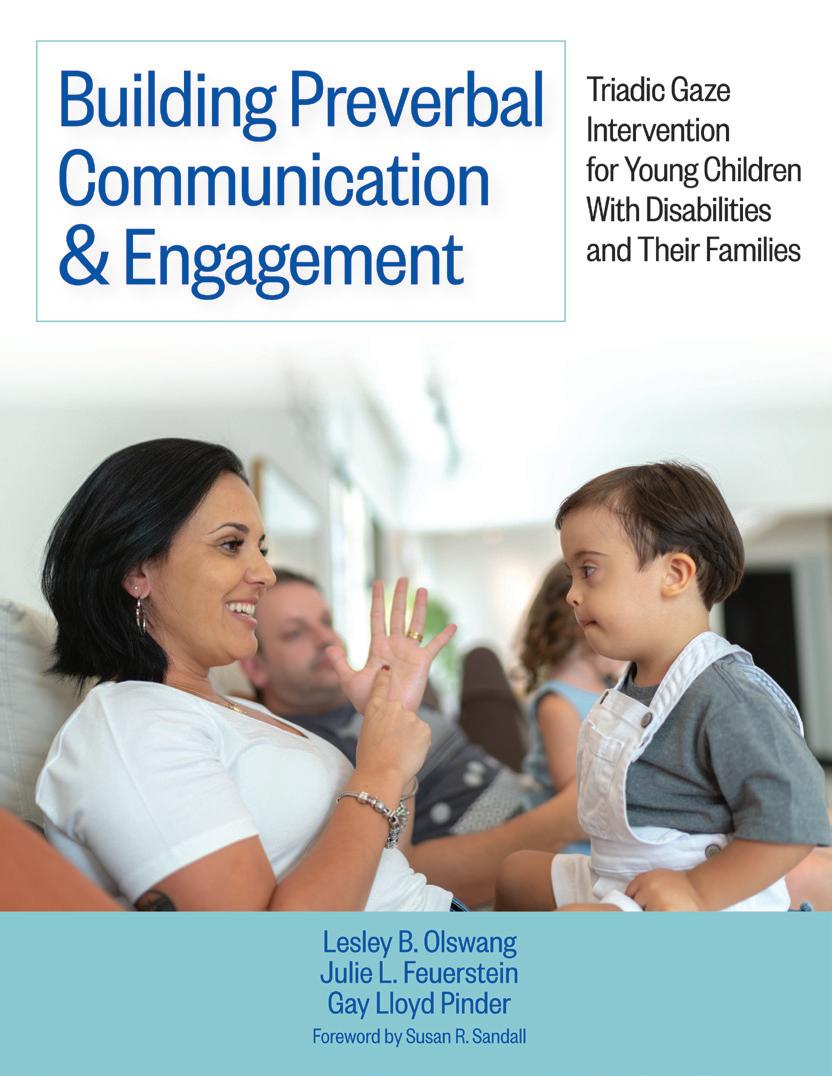
• Learn about the six elements of the authors’ PoWRRS-Connect protocol for implementing TGI: providing opportunity, waiting, recognizing, responding, shaping, and connecting
• Use the protocol to help children make progress toward IFSP goals related to communication and engagement
• Tailor the protocol for individual children with a range of disabilities and needs, including motor, sensory, or social impairments
• Embed opportunities for communication and engagement into each family’s authentic routines and activities
• Facilitate stronger collaborative partnerships with caregivers
• Discover how to monitor small measures of progress in engage ment and communication through the lens of TGI
• Learn from four parents of children with complex communication needs, who share their success stories with TGI and describe their children’s current communication methods and abilities
PRACTICAL MATERIALS: Easily implement the PoWRRS-Connect protocol in families’ daily routines with the downloads available online, including handouts for caregivers, a communication checklist for assessment, and 19 brief demonstration videos.
SECTION I: UNDERSTANDING EARLY COMMUNICATION DEVELOPMENT AND TRIADIC GAZE INTERVENTION
The Child–Adult Dance and the Gift of Engage ment and Communication
When the Dance Is Interrupted: Young Children With Disabilities and Intervention
How Triadic Gaze Intervention Evolved in the Context of Early Intervention
SECTION II: IMPLEMENTING TRIADIC GAZE INTER VENTION
Introduction to the Triadic Gaze Intervention
Integrating Triadic Gaze Intervention Into Practice
The Essential Elements of PoWRRS-Connect: Delivery Guidelines
Putting PoWRRS-Connect Into Action With Fami lies

Tips for Tailoring Triadic Gaze Intervention and PoWRRS-Connect With Families
Monitoring Progress

SECTION III: FOLLOWING THE TRIADIC GAZE IN TERVENTION JOURNEY WITH CHILDREN AND FAMILIES
Triadic Gaze Intervention and Beyond

Autobiographical memory (ABM)—the type of long-term memory that holds information about ourselves and our past experiences—is key to social learning and social communication. This groundbreaking guide shows professionals how to support ABM in children and adolescents on the autism spectrum, leading to lasting enhancements to critical social skills.
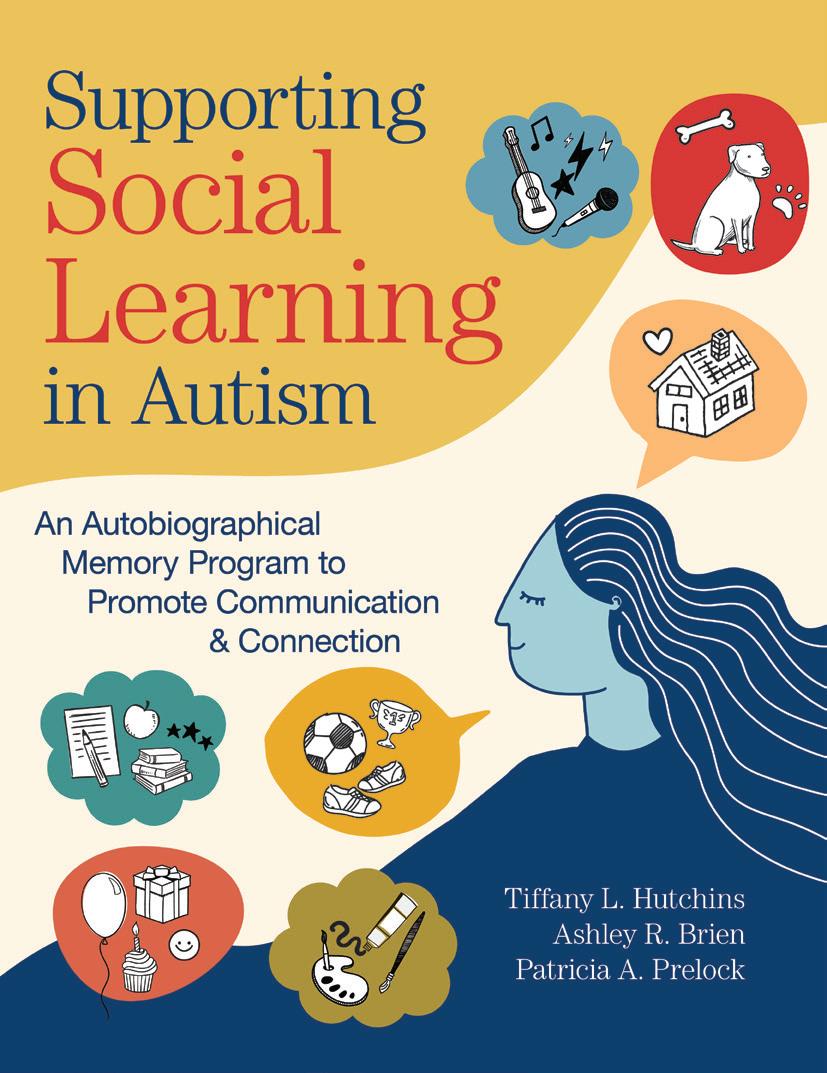
A natural, strengths-based approach to autism intervention, this unique program is about promoting authentic connections by facilitating memory—not encouraging a specific set of behaviors or changing autistic habits of cognition. Ideal for speech-language pathologists and other practitioners, this book offers detailed guidance on how to assess ABM needs and implement activities that help autistic individuals encode and retrieve memories that aid in social learning. Professionals will get step-by-step instructions on using adaptable, person-centered techniques such as elaborative reminiscing, memory making activities, episodic memory draw-talks, and life stories.
• Helps neurotypical and autistic children and adolescents develop memory retrieval and discourse strategies critical for academic and social success
• Evidence aligned—translates pioneering research into ready-touse intervention strategies and activities
Client centered—honors the child’s interests and follows their lead without prescribing scripts or rules
Adaptable for a wide range of intervention settings—home, school, and community
by highly respected experts on autism
meet the needs of the individual
MATERIALS:
replicate,

will get downloadable as
forms, clear scope and sequences they can
handouts and worksheets to share with families so
at home.
Evidence-Based Intervention Strategies for Communication & Social Interactions, Second Edition
Edited by Patricia A. Prelock, Ph.D., CCC-SLP, BCS-CL (University of Vermont), & Rebecca J. McCauley, Ph.D., CCC-SLP (The Ohio State University)

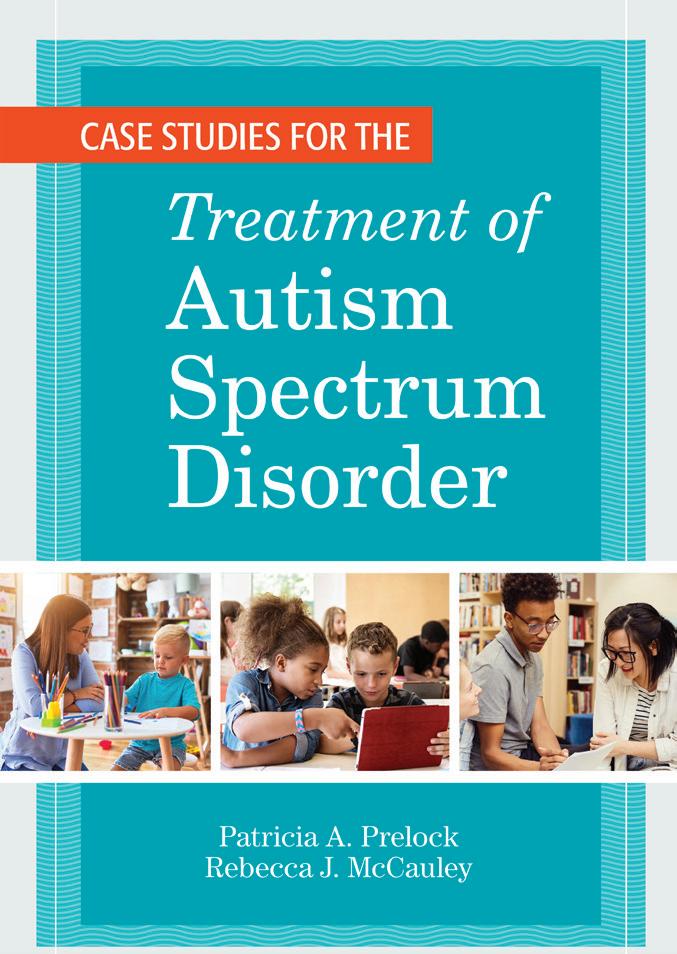

Edited by Patricia A. Prelock, Ph.D., CCC-SLP, BCS-CL, & Rebecca J. McCauley, Ph.D., CCC-SLP
To work effectively with individuals who have autism spectrum disorder (ASD), SLPs and other practitioners need in-depth knowledge on choosing and implementing interventions for communication and social challenges. The second edition of this bestselling textbook— and the new companion casebook—gives future professionals the foundation they need to evaluate today’s widely used interventions and determine which ones will promote the best outcomes for the people they serve.
TEXTBOOK: Enhanced with video clips that illustrate the interventions in action, this textbook prepares professionals to evaluate and compare 14 evidence-based interventions for children with autism spectrum disorder. New features include updates to reflect the DSM-5, in-depth profiles and videos of three interventions not covered in the last edition, more on inclusive practices and children from culturally and linguistically diverse backgrounds, a new chapter on assessment for treatment planning and progress monitoring, a sample syllabus for faculty, and more.
CASEBOOK: Developed as a companion to the text, this resource offers 14 realistic case studies that walk your students through common clinical challenges and help them hone their planning and problem-solving skills. Aligned with the 14 intervention chapters in the text, the case studies include a complete profile of the child’s strengths and needs, an overview of the assessment practices and intervention plan, a report on the child’s outcomes, and more.
BUNDLE:
Textbook: US$79.95
US$29.95
978-1-68125-396-1

To help ensure the best outcomes for learners with autism spectrum disorder, speech-language pathologists (SLPs) and behavior analysts (BAs) need to work together to support positive behavior and effective communication. This book provides tomorrow’s SLPs with a clearer un derstanding of applied behavior analysis (ABA)—and bridges the gap between the two fields with a comprehensive plan for collaboration.
An important new addition to courses in speech-language pathology, this textbook clears up the myths and misconceptions surrounding ABA and builds a clear path to interprofessional practice between SLPs and BAs. Through chapters coauthored by practitioners from both disciplines, future SLPs will learn how to move past ABA stereo types and controversies, incorporate the best ABA-based practices into their work, and break down the barriers to productive collabora tion with BAs. An essential part of every preservice SLP’s education, this timely text shows how experts from two vital fields can learn from each other and work as a seamless team to support better lives for people with autism.
• Discover why SLPs should collaborate with behavior analysts and get practical strategies for connecting with BAs and learning from their expertise
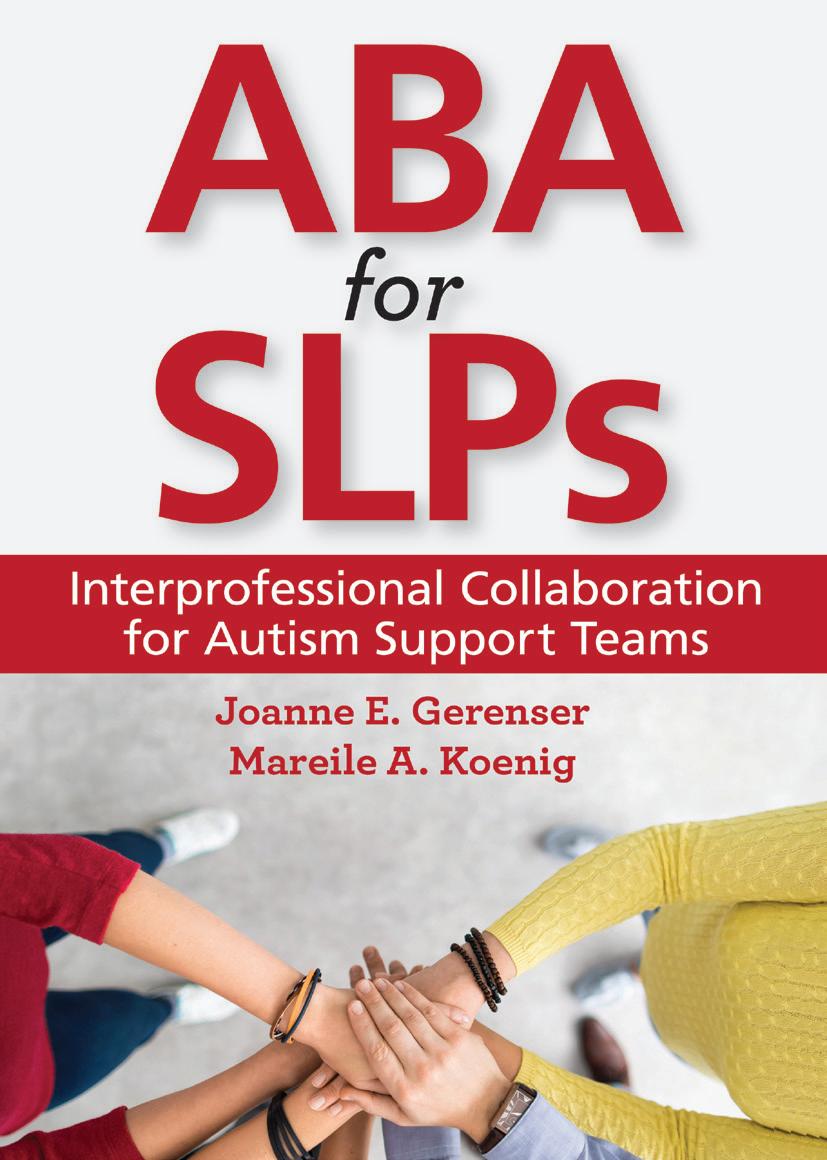
• Master the fundamentals of ABA, including its key terminology, its core behavioral teaching components, and its data collection methods
• Learn how to apply the interprofessional education and interpro fessional practice model (IPE/IPP)—a framework widely used in health care and education—to collaboration with BAs

• Get step-by-step guidance on using proven ABA-based interven tions, including the analysis of verbal behavior, Pivotal Response Treatment, Incidental Teaching, and the Picture Exchange Com munication System
Learn how to integrate ABA with speech-language pathology
areas, including assessment, goal-setting, and behavior

objectives, reflection questions, vignettes, and a helpful
for
absorb and apply new
Edited by Jennifer B. Ganz, Ph.D., BCBA-D (Texas A&M University), & Richard L. Simpson, Ed.D. (formerly of University of Kansas)
“This book is a ‘must-have’… There is no better re source on intervention to support the communication and participation of individuals with ASD who have minimal or no speech.”
—Janice Light, Penn State University
People who have both autism spectrum disorder and complex com munication needs require specialized, multidisciplinary interventions and supports to boost their independence and quality of life. Find up-to-date, evidence-supported information and strategies in this textbook, a volume in the respected Augmentative and Alternative Communication series.

This essential resource brings together more than 30 internationally recognized researchers from three important disciplines: augmenta tive and alternative communication (AAC), special education, and applied behavior analysis (ABA). Preservice practitioners will discover how to combine key interventions from these disciplines to make positive differences in the lives of the people they work with.
With this meticulously researched guide to today’s best strategies and supports, your students will have the information they need to improve outcomes for people with autism and complex communication needs.
• Using evidence-based teaching methods with learners of all ages
• Conducting effective assessment and linking results with intervention planning
• Selecting high-tech and low-tech AAC options that meet individual needs
• Bringing about lasting changes to behavior with functional communication training
• Evaluating specific interventions that target social communication
• Implementing parent- and peer-mediated interventions
• Using customized visual and environmental supports in a variety of settings


1. Characteristics of Individuals with Autism Spectrum Disorder Who Have Complex Communication Needs
2. Autism-Focused Assessment and Program Planning
3. Overview of Evidence-Based Practices for Individuals with Autism Spectrum Disorder and Complex Com munication Needs
4. Overview of AAC for Individuals with Autism Spec trum Disorder and Complex Communication Needs
5. Considerations in Implementing Aided Low-Tech AAC Systems for Individuals With Autism Spectrum Disorder and Complex Communication Needs
6. High-Tech Aided AAC for Individuals With Autism Spectrum Disorder and Complex Communication Needs
7. Functional Communication Training for Durable Behavior Change
8. Effective Strategies for Working with Young Children with Autism Spectrum Disorder and Complex Com munication Needs
9. Evidence-Based Methods for Teaching School-Age Children and Youth with Autism Spectrum Disorder and Complex Communication Needs
10. Evidence-Based Practices for Adolescents and Adults With Autism Spectrum Disorder and Complex Com munication Needs
11. Naturalistic Developmental Behavioral Interventions for Young Children With Autism Spectrum Disorder and Complex Communication Needs
12. Parent- and Peer-Mediated Interventions for Children With Autism Spectrum Disorder and Complex Com munication Needs
13. Visual and Environmental Supports for Learners With Autism Spectrum Disorder and Complex Communi cation Needs
Conclusions and Directions for Future Research
Introduction to Treatment of Language
INTERVENTIONS TARGETING EMERGING COMMUNICATION AND LANGUAGE
Hanen Programs for Parents: Parent-Implemented
Language Intervention
Responsivity Education/Prelinguistic Milieu Teaching
Enhanced Milieu Teaching
Focused Stimulation Approach to Language Intervention

Edited by Rebecca J. McCauley, Ph.D. (The Ohio State University), Marc E. Fey, Ph.D., CCC-SLP, (professor emeritus, University of Kansas Medical Center), & Ronald B. Gillam, Ph.D. (Utah State University)
—Chris Dollaghan, Ph.D., CCC-SLP, School of Behavioral and Brain Sciences, University of Texas at Dallas
Thoroughly updated to meet the needs of today’s students in SLP courses, the second edition of this classic textbook prepares future professionals to evaluate, compare, select, and apply effective inter ventions for language disorders in children. Using realistic case stud ies and many new video clips that show each strategy in action, the expert contributors introduce your students to 14 current, researchbased intervention models and examine practical ways to apply them in the field. The new edition covers interventions for both emerging communication and language and more advanced language and literacy, in a consistent chapter format that makes it easy for students to compare treatment approaches. A textbook SLPs will keep and ref erence often throughout their careers, this balanced, in-depth look at interventions will prepare professionals to choose and implement the best interventions for children with language disorders.
• the theoretical and empirical basis of each intervention
target populations for the intervention
System for Augmenting Language:
and Emerging Language Intervention
Interventions: A Framework for Improving Children’s Print Knowledge
Awareness
Language
Building
for Successful Early Literacy
for Preschool Children with
INTERVENTIONS TARGETING MORE ADVANCED LANGUAGE AND LITERACY
Intervention for School-Age Bilingual
and Application
Reading Intervention
Communication
Interventions for Word Decoding and Reading Comprehension
Sentence Intervention
Knowledge in Language and Literacy:
Narrative-Based Language Intervention
Communication Intervention for Children
Language Impairment
Service Delivery
• assessment and decision making
practical requirements for implementation
considerations for children from culturally and linguistically diverse backgrounds
future directions
STUDENT-FRIENDLY MATERIALS: A video clip to illustrate each intervention (available online on our Download Hub); case studies; learning activities that challenge students to apply their new
Language Intervention for School-Age Bilingual Children
Comprehensive Reading Intervention in Augmentative

Narrative Language Intervention
Complex Sentence Intervention
Social Communication Intervention for Children with Language Impairment
Strathclyde Language Intervention

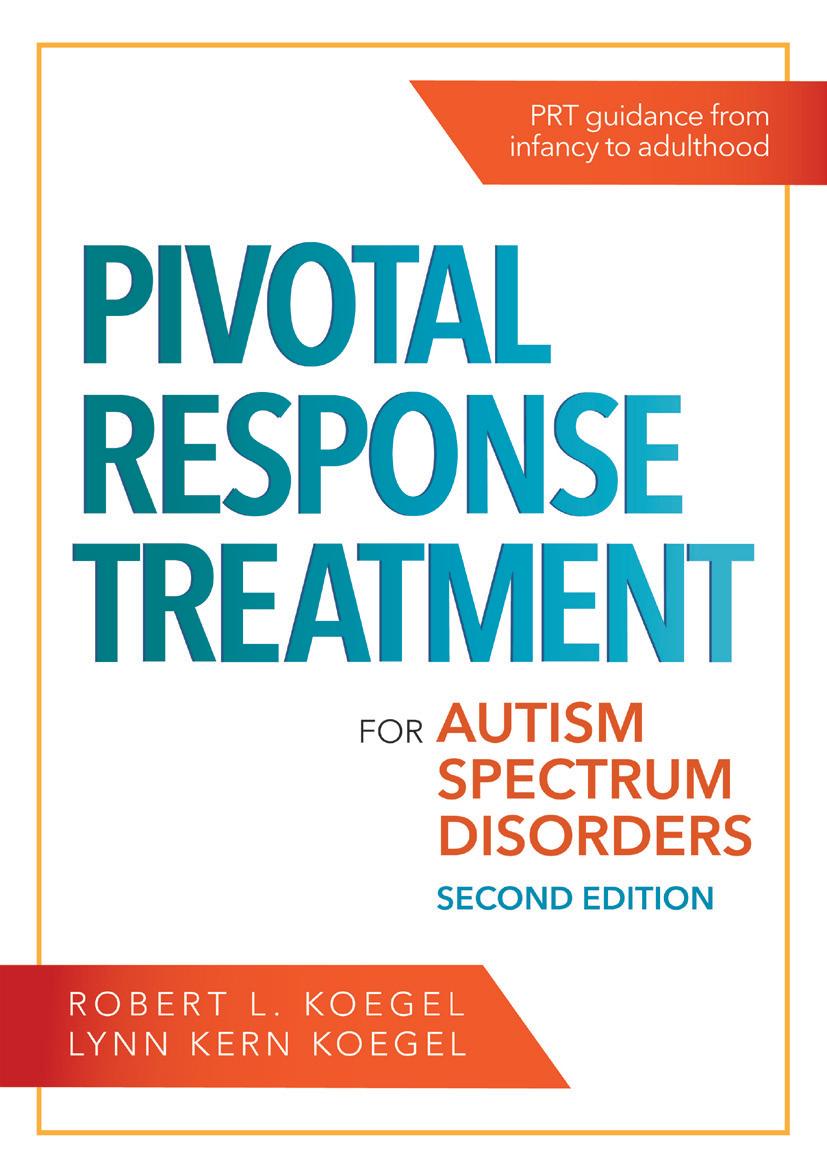
Edited by Robert L. Koegel, Ph.D. (Stanford University School of Medicine), & Lynn Kern Koegel, Ph.D. (Stanford University School of Medicine), with invited contributors
The pioneering experts behind Pivotal Response Treatment have created a comprehensive modern guide to this highly respected, research-based approach, completely reworked and revised for a new generation of therapists and educators. Strengthened with new research and more step-by-step guidance, this bestselling PRT text is now reorganized to support children on their whole developmental trajectory, from infancy through adulthood. New and revised chapters cover critical topics—including assessment and self-management— and the book’s down-to-earth, accessible style ensures that your students can grasp PRT principles and apply them effectively.
With this proven approach backed by more than 25 years of research, future professionals will be ready to support children with autism as they enjoy more positive interactions, more effective communication, and higher academic achievement.
• Advance children’s communication and language skills
• Aid early identification and intervention
• Improve children’s motivation and performance in school
• Foster friendships with peers
• Increase positive behavior by combining functional assessment and self-management strategies
• Decrease disruptive behavior
• Help young adults make a smooth transition to college, career, and community life
Each chapter features learning goals, key insights to remember, and helpful study questions (also available online to download and print).
New and completely reworked chapters on working with infants and toddlers, linking strengths-based assessment to treatment planning, improving adolescents’ communication and social skills, teaching par ents how to implement PRT, combining functional behavioral assess ment and self-management strategies, helping young adults succeed in college and the workplace.
I. OVERVIEW: PIVOTAL RESPONSE TREATMENT IN CONTEXT


The History and Basic Components of Pivotal Response Treatment
Assessment, Feedback, and Treatment Planning
Ecocultural Theory and Cultural Diversity
BEGINNING STAGES: EARLY INTERVENTION
Intervention for Infants and Young Toddlers
Teaching First Words
Expanding Friendship Opportunities for Children with ASD
III. CHILDHOOD: TREATMENT OPTIONS AT HOME AND AT SCHOOL
Parent Education in Pivotal Response Treatment
Inclusive Education
Motivational Academics
IV. ADOLESCENCE AND YOUNG ADULTHOOD: MOV ING TOWARD INDEPENDENCE
Functional Behavior Assessment and Self-Management
Improving Communication Skills in Adolescents
Adults with ASD
Improving Socialization in Adolescents and Adults with
V. ADULTHOOD: HIGHER EDUCATION AND EMPLOYMENT
Improving Outcomes in Higher Education for Adults with ASD
Supporting Individuals with ASD in Employment Settings
For forty years, this textbook has been the gold-standard resource for providing speech-language pathologists with a strong foundation of knowledge on speech sound disorders. Previously published as Articulation and Phonological Disorders, this core text is now in its ninth edition, fully updated and expanded to prepare today’s clinicians for their work with children of all ages.

A cornerstone of every SLP’s professional preparation, the new edition of this book offers the most up-to-date, comprehensive coverage of contemporary clinical literature and the best available treatments for speech sound disorders. With a focus on evidence-based practice, the expert authors and contributors present essential information and guidelines on a broad range of topics, from the basics of typical speech production to recommended practices for assessment and intervention. Updates include new and expanded chapters on timely topics, new instructor materials and student-friendly features, and helpful guidance for clinicians serving an increasingly diverse population.

• All chapters fully updated with the latest research and recommended practices
• New chapter on treatment of childhood apraxia and speech sound disorders in older children
• Expanded guidance on evidence-based practices and treatments
More on motor-based approaches to treatment
Extended discussion of language variation and dialect
New chapter on accent modification
New student-friendly features such as learning objectives and clinical vignettes to demonstrate treatment practices

Updated Online Instructor’s Resource Manual and Test Bank
MATERIALS: Faculty can easily incorporate this text
their course with the fully updated online Instructor’s Resource Manual and Test Bank. Included are key points, discussion topics, and instructional ideas for each chapter, plus a bank of multiple choice, short answer, and essay questions.
Edited by A. Lynn Williams, Ph.D. (East Tennessee State University), Sharynne McLeod, Ph.D. (Charles Sturt University), & Rebecca J. McCauley, Ph.D. (The Ohio State University)
An essential building block of every speech-language pathologist’s professional preparation, the second edition of this bestselling text book is a comprehensive critical analysis of 21 interventions for highly prevalent speech sound disorders (SSD) in children. Bringing together a powerhouse team of international experts, this new edition has been revised and enhanced with current research, new interventions, more guidance on selecting interventions, and updated video clips that show the approaches in action. For each intervention, your students will get a clear explanation of its robust evidence base, plus thorough guidance on implementing the approach, monitoring progress, and using the intervention with children from culturally and linguistically diverse backgrounds.
A key graduate-level text for future SLPs, early interventionists, and special educators, this book will help readers choose and use the best interventions for children with functional or motor-based speech disorders.

• 18 high-quality video clips that offer a vivid inside look at interven tion techniques in action
Expanded information on choosing interventions and implement ing them with fidelity
New featured interventions, including Dynamic Temporal and Tac tile Cueing and biofeedback approaches


Up-to-date research on SSD and interventions, including Levels of Evidence tables that help readers evaluate the evidence base for each intervention
In-depth discussion of how the interventions relate to the World Health Organization’s model of participation
New learning activities that help readers
Learning How to Implement Interventions with Ac ceptable Fidelity
Minimal Pairs Intervention
Multiple Oppositions Intervention
Complexity Approach
Phonological Awareness Intervention
Psycholinguistic Intervention
Tools for Interventions
Core Vocabulary Intervention
Cycles Approach
Approach
Milieu Teaching with Phonological
Recast Intervention
and Speech Sound
Phonological Intervention
Interventions
Nuffield Centre Dyspraxia
PROMPT
Motor Programming Intervention
Temporal and Tactile Cueing
the Best
Introduction to How AAC Can Promote Communi cation, Speech, and Language in Individuals With Down Syndrome Across the Life Span
Introduction to Individuals With Down Syndrome
Speech Intelligibility and Communication in Down Syndrome
Overview of Multimodal AAC Intervention Across the Life Span for Individuals With Down Syndrome
Integration of AAC Into Early Language Interven tion With Children With Down Syndrome
Language Development of School-Age Children and Adolescents With Down Syndrome and Perti nent Interventions That Integrate AAC
Adolescents and Adults With Down Syndrome: Supporting Communication and Participation With AAC

Assessment and Intervention of Cognitive and So cial Functioning in Adolescents, Young Adults, and Older Individuals With Down Syndrome
Collaborating With Families to Support Multimodal AAC for Individuals With Down Syndrome

Supporting Communication and Self-Advocacy
Special Health and Medical Needs and Services

Literacy and Access to Technology
Edited by Krista M. Wilkinson, Ph.D. (The Pennsylvania State Univer sity), & Lizbeth H. Finestack, Ph.D., CCC-SLP (University of Minnesota)
Many people with Down syndrome—one of the most common genetically-linked developmental disabilities—experience difficulty developing spoken and written communication skills. In this ground breaking book, discover how augmentative and alternative communi cation (AAC) can enhance communicative competence and improve outcomes for people with Down syndrome across the lifespan. The newest volume in Beukelman and Light’s respected Augmentative and Alternative Communication Series, this book fully explores how interdisciplinary, multimodal AAC strategies can promote speech, lan guage, and literacy success across many contexts, including homes, schools, communities, health care settings, and the workplace.
Bringing together an interdisciplinary group of more than 25 experts, this book is a key supplementary text for courses on AAC and de velopmental disabilities. Your students will use the research-based guidance to help people with Down syndrome develop stronger communication skills and participate meaningfully in their schools and communities.
• Skillfully pair unaided AAC supports (gestures and manual signs) with aided AAC (technology and other supports external to the body)
• Enrich young children’s communication and language development with AAC
• Use AAC to boost older children’s vocabulary, grammatical lan guage, and narrative language skills
• Enhance reading instruction using AAC technology
• Supplement speech and improve speech intelligibility with care fully chosen interventions and visual communication aids
• Engage whole families as collaborative partners to integrate AAC supports into everyday life
• Address young adults’ communication needs, as they evolve to include more varied communication partners, more complex top ics, and new contexts
Assess cognitive and social functioning in adolescents and adults
Support communication and self-advocacy across health care settings with AAC strategies
The authoritative text on augmentative and alternative communica tion, this classic bestseller is now in its fifth edition—revised and up dated for a new generation of SLPs, teachers, occupational therapists, and other professionals in clinical and educational settings. Partnering with a team of distinguished contributors, renowned experts David Beukelman and Janice Light deliver today’s most comprehensive, up-to-date introduction to AAC interventions and technologies for children and adults with complex communication needs. Future ser vice providers will get in-depth coverage of essential AAC topics, en hanced by helpful study questions, valuable perspectives from people who use AAC, and case examples that illustrate key principles.

Significantly expanded with new chapters and companion materials, this definitive text will expertly prepare readers to support communi cative competence for children and adults with complex communica tion needs.
Professionals will prepare for their work in the field with critical new information on:
• Collaborating with family members and other communication partners
• Making the most of mobile technologies and AAC apps
• Selecting an AAC system and tailoring it to individual needs
• Working effectively with families from diverse cultural backgrounds
• Supporting inclusion across the lifespan (including education, employment, and community life)
• Ensuring efficient patient–provider communication in medical settings


• Providing communication supports to people with autism spectrum disorder
NEW ONLINE COMPANION MATERIALS include a resource guide to help practitioners and students learn more about AAC, sample responses to chapter study questions, and a sample syllabus.
978-1-68125-303-9
SECTION I. PEOPLE WHO REQUIRE AAC
AAC Assessment
Overview of AAC Intervention
Collaborating with Family Members and Other Communication Partners
SECTION II. AAC SYSTEMS
Vocabulary Selection and Message Management
Representation, Organization, and Layout of AAC Systems
Selection and Personalization of AAC Systems
SECTION III. AAC INTERVENTIONS FOR INDIVIDUALS
WITH DEVELOPMENTAL DISABILITIES
Intervention to Support Communication and Partici pation of Beginning Communicators
Intervention to Build Communicative Competence
Literacy Intervention for Individuals with Complex Communication Needs
SECTION IV. AAC INTERVENTIONS FOR INDIVIDUALS
WITH ACQUIRED DISABILITIES
Individuals with Acquired Physical Conditions
AAC Supports for Adults with Severe Aphasia and/or Apraxia of Speech
Adults with Degenerative Cognitive and Linguistic Conditions
Individuals with Traumatic Brain Injury
Patient-Provider Communication in Medical Settings
SECTION V. FINAL THOUGHTS
The Importance of Advocacy
FOUNDATIONAL TOPICS


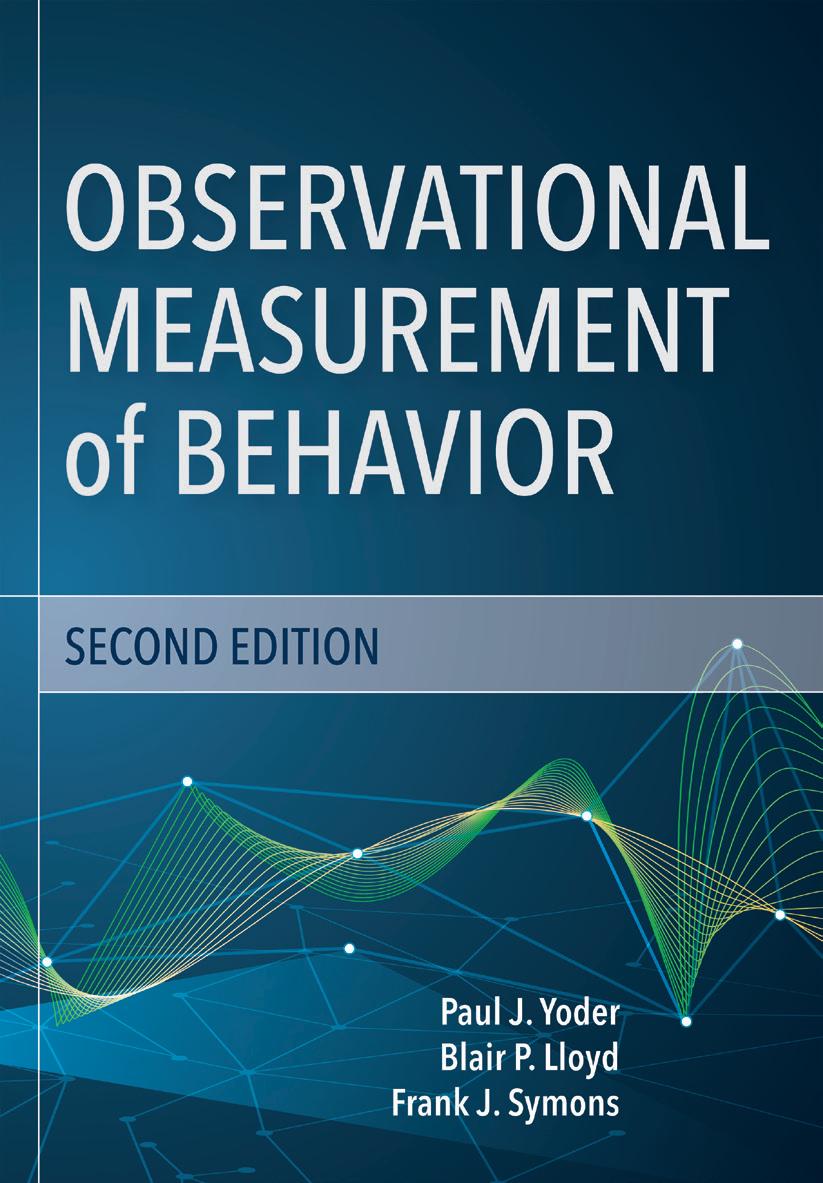
An essential textbook for anyone preparing to be a researcher, this comprehensive volume introduces graduate students to key prin ciples of observational measurement of behavior. Based on a course the highly respected authors taught at Vanderbilt University and the University of Minnesota, this text delves deeply into a highly effective approach to observational measurement: systematic observation.
Students will master both the theoretical principles of systematic observation and recommended research methods and techniques. They’ll learn from practical examples that illustrate complex concepts, clear explanations of recommended research methods, definitions of key terms, and exercises and assignments that help them practice putting principles into action. Online companion materials include two six-month licenses for proprietary observational software that students can use to complete the exercises and assignments in this book.
Ideal for use in research methodology courses in diverse fields, this fundamental graduate text will prepare future researchers to skillfully collect, summarize, and communicate their observations of children’s behavior.
ONLINE COMPANION MATERIALS: To enhance their courses, instructors will get a full package of online materials, including two six-month licenses for observational software, a media file students can use to practice coding behaviors, a suggested schedule for a semester-long course, exercises for students, and assignments with corresponding grading rubrics.

Howard Shane tells the story of his first teaching
School for people with disabilities. Howard’s belief that
creative, determined steps he takes to unlock his students’
communication professional.
By Howard C. Shane, Ph.D. (Boston Children’s Hospital, Harvard Medical School)

Edited by Rhea Paul, Ph.D., CCC-SLP (Sacred Heart University), & Elizabeth Schoen Simmons, M.S., CCC-SLP (Sacred Heart University)
Fully updated and revised based on the 2020 ASHA standards and re cent AAA standards, the new edition of this bestseller is the core text book for all students in clinical methods courses—and a reliable refer ence for practicing SLPs and audiologists. Leading authority Rhea Paul and newly minted research scholar Elizabeth Schoen Simmons bring together more than 20 academics and clinicians for a state-of-the-art guide to contemporary evidence-based practice. Covering a broad range of disorders and developmental levels, this text sets emerging professionals on the path toward mastering all the fundamentals of practice, from conducting effective assessment and intervention to ensuring that practices are family-centered and culturally inclusive. Tomorrow’s clinicians will use this foundational textbook to guide their professional decision-making and provide the best possible services for people with communication disorders.
• New chapter on using principles of observation to gather accurate, valid data in clinical settings and more deeply understand clinical processes and procedures
• Expanded information on intervention principles, with case studies highlighting practical applications and an emphasis on evidencebased practice
• More on counseling in communication disorders, clinical documen tation, relationships with supervisors, and single-case experimental design
• Updated information on technology in clinical practice
New emphasis on automated analysis of communication samples
Chapters on clinical competence and family-centered practice by renowned experts
New student-friendly text features, such as learning objectives, study questions, and problem-solving questions
Case studies and clinical examples throughout
Reflects most recent ASHA and AAA standards
WITH NEW FACULTY MATERIALS, including a test bank for each chapter and suggested projects that professors can assign students to practice the principles outlined in each chapter.
Introduction to Clinical Practice in Communication Disorders
Ethical Practice in Communication Disorders
Evidence-Based Decision Making in Communication Assessment and Intervention
Principles of Communication Assessment
Communication Sampling Procedures
Communication Intervention: Principles
Procedures
Professional Communication: Effective Counseling Techniques and Clinical Documentation Strategies
Public Policies Affecting Clinical Practice


Clinical Service Delivery and Work Settings
Issues of Cultural and Linguistic Diversity
Technology and Communication Disorders
Family-Centered Practice
Principles of Clinical Observation
Note: Trainees each should purchase a Practice Kit for use in their coursework or TILLS training session. Instructors should have their own Practice Kit, and they may request a desk copy of the Examiner’s Manual (as it is not included in the Practice Kit).
Examiner’s Practice Workbook: More than 100 pages of exercises on subtest administration, scoring TILLS, and interpreting results, plus a tutorial to help you master T-unit division.
Practice Kit Downloads: The audio files and normative data tables needed to complete the scoring of the exercises in the Examiner’s Practice Workbook (downloaded with a special code that is provided to the purchaser).
Examiner Record Form (pack of 3): Two forms to work through the exercises in the Workbook for students of different ages, plus an extra copy of the form for additional practice.
Quick Start Guide: A laminated trifold quick-reference guide to administration and scoring, perfect to take with you when using TILLS on the job and as a quick reference for trainees.
 By Nickola Wolf Nelson, Ph.D., Elena Plante, Ph.D., Nancy Helm-Estabrooks, Sc.D., and Gillian Hotz, Ph.D.
By Nickola Wolf Nelson, Ph.D., Elena Plante, Ph.D., Nancy Helm-Estabrooks, Sc.D., and Gillian Hotz, Ph.D.
These convenient Practice Kits include the materials needed for training and practice sessions with the Test of Integrated Language & Literacy Skills™ (TILLS™), a test valid and reliable for assessing oral and written language skills in students ages 6–18 years. The TILLSTM Practice Kit gives you and your trainees access to essential materials for learning about TILLS and, in the process, about standardized testing in general.
The TILLS Practice Kits are ideal for use in preservice higher education courses and inservice trainings. They can help you introduce TILLS to aspiring or experienced professionals—and give them the practice they need to use TILLS and perform individualized assessment with confidence in future work settings.
• Give trainees a complete overview of TILLS. Introduce the TILLS subtests and the three purposes of the assessment: identifying language/literacy disorders, documenting relative strengths and weaknesses, and tracking changes over time.


• Familiarize trainees with the 15 TILLS subtests. With the included Examiner’s Practice Workbook, TILLS trainees will work through practice exercises for each subtest that prepare them for successful administration of the TILLS and other standardized tests.
• Provide concrete examples of standardized testing principles. Beyond testing with TILLS, the materials of the Practice Kit can be used to emphasize assessment principles in general, such as using start rules, establishing basals and ceilings, and using standardized instruction and scoring procedures with fidelity.
• Provide scoring practice. Using the Examiner’s Practice Workbook and downloadable audio files, TILLS trainees will practice scoring and interpreting all subtests, with extra instructional material and practice examples for the Written Expression subtest.
With this thorough introduction to a landmark language and literacy assessment, pre- and inservice professionals will be ready to use TILLS to enhance their future work in schools, clinics, and private practice.
US$49.95 | Stock #: 51981 | 2016 | Shrink-wrapped | ISBN 978-1-68125-198-1
Edited by Mary Pat Moeller, Ph.D. (Boys Town National Research Hospi tal), David J. Ertmer, Ph.D. (Purdue University), & Carol Stoel-Gammon, Ph.D. (University of Washington, Seattle)
What are the best interventions for support ing language acquisition and literacy for children who are deaf or hard of hearing (D/ HH)? This comprehensive textbook-andDVD set brings the answers to life for tomorrow’s speech-language pathologists, audiologists, and educators. A vital addition to the respected Communication and Language Intervention (CLI) series, this important volume enlisted more than a dozen experts to present evidence-based intervention approaches, spanning the critical early years of language development through the complex reading and writing challenges of the school years.
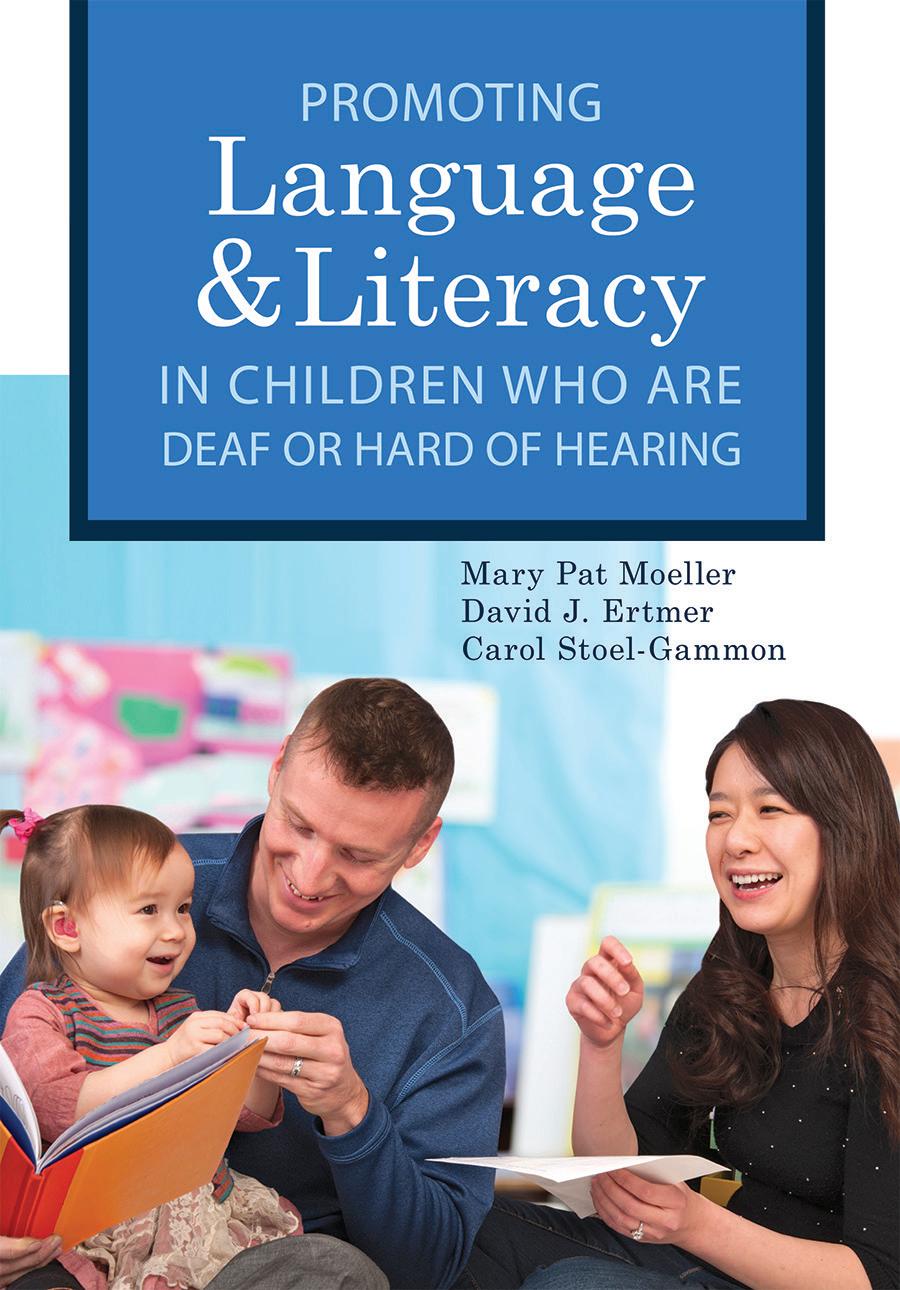
Chapters cover a continuum of available communication approach es—from auditory-focused to visually-focused to simultaneous use of speech and sign—while encouraging the use of individualized interventions to meet each child’s needs. To prepare professionals for decades of effective, evidence-based practice, the included video clips demonstrate how to implement assessments and interventions and work successfully with children and families.
• audiological assessments and technological interventions for chil dren

• principles and practices for family-centered early intervention
• understanding, supporting, and coaching families
• assessments to identify intervention priorities
Theory of Mind
auditory-verbal therapy and phonological interventions
sign language and sign systems
use
the internet

deliver intervention
elements of supportive early education
approaches for optimizing reading and
strategies for promoting social and academic
1. Promoting Language and Literacy Development in Children Who are Deaf or Hard of Hearing: An Introduction
FOUNDATIONS OF INTERVENTION
Audiological Interventions for Infants and Pre schoolers
Supporting Families
EARLY CHILDHOOD INTERVENTIONS
Family-Centered Early Intervention: Principles, Practices, and Supporting Research
Family-Centered Early Intervention: Supporting Spoken Language Development in Infants and Young Children
Sign Language, Sign Systems, and Other Visual Modalities
Auditory-Verbal Therapy: A Conversational Com petence Approach
Phonological Development and Intervention Ap proaches for Children Who are Deaf or Hard of Hearing
Supportive Early Childhood Practices and Learning Environments
Internet Therapy: Providing Listening and Spoken Language Intervention to Children Who are Deaf or Hard of Hearing
III. LANGUAGE AND LITERACY IN THE SCHOOL YEARS
Reading the World: Supporting Theory of Mind Development in Deaf or Hard-of-Hearing Students
Models for Facilitating Literacy Development
Teaching Writing: Principles into Practice
Educational Advocacy Across the Curriculum
Literacy improves lives—and with the right instruction and supports, all students can learn to read and write. That’s the core belief behind this book, an essential guide to providing comprehensive, high-quality literacy instruction to students with significant disabilities.
Drawing on decades of classroom experience, the authors present their own innovative model for teaching students with a wide range of significant disabilities to read and write print in grades preK–12 and beyond. Foundational teaching principles blend with concrete strategies, step-by-step guidance, and specific activities, making this textbook a complete blueprint for helping students acquire critical literacy skills they’ll use inside and outside the classroom.
• Discover 10 success factors for helping students with significant disabilities become literate
Prepare to teach emergent readers and writers skillfully, with evidence-based strategies for shared and independent reading, early writing instruction, and alphabetic and phonological aware ness
• Learn how to help students acquire conventional literacy skills, with adaptable strategies for teaching reading comprehension, vocabulary, writing, decoding, and spelling
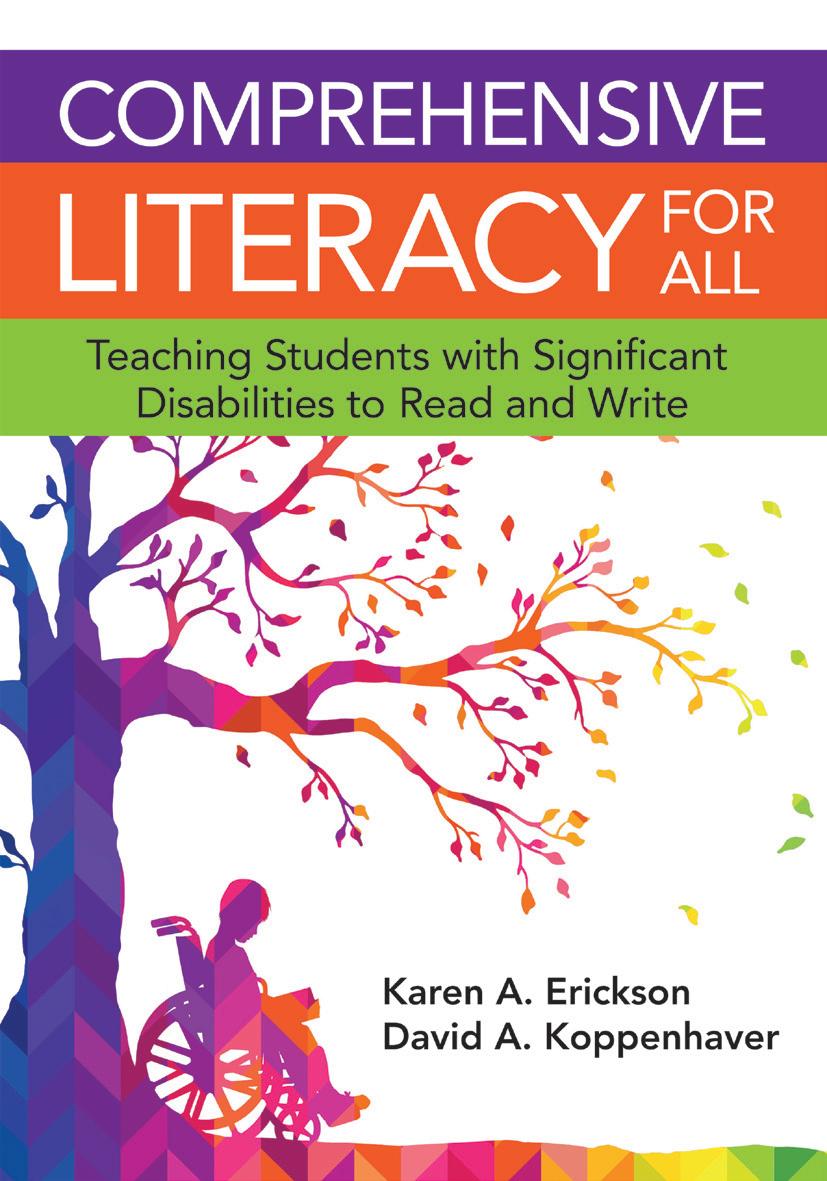
Get ready to organize and deliver comprehensive literacy instruc tion in a variety of settings, both inside and outside of school
See how to use assistive technology effectively to support read ing, writing, and communication


tips on how to engage and motivate students and make literacy instruction
PRACTICAL MATERIALS:
to their everyday
teaching scenarios
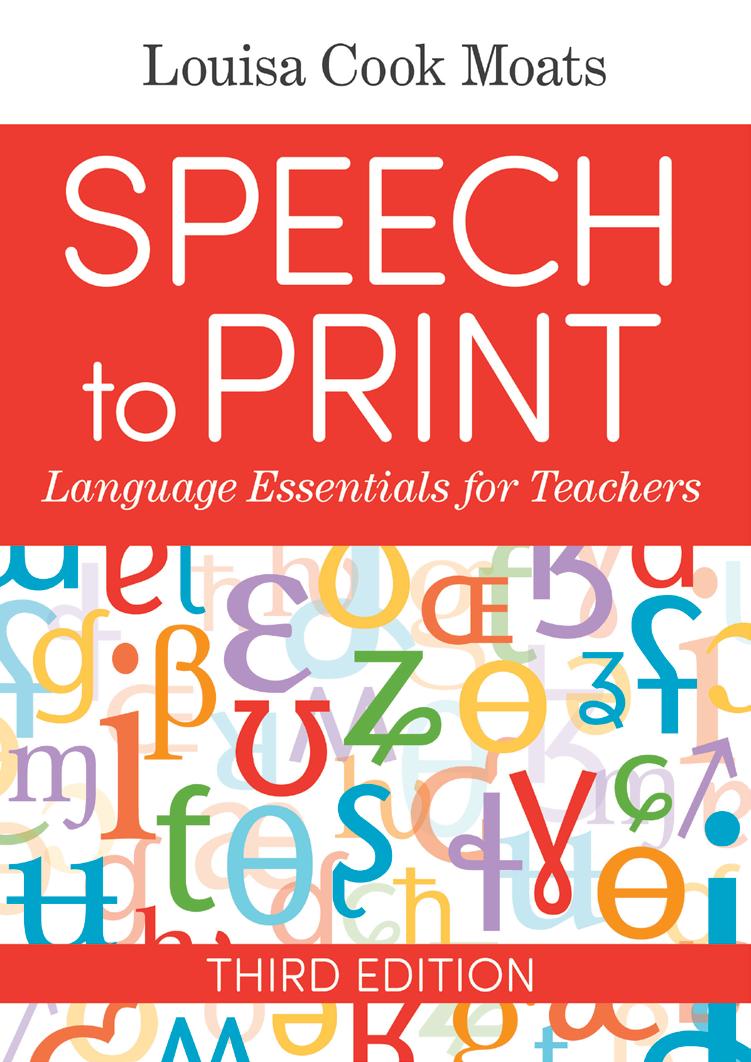
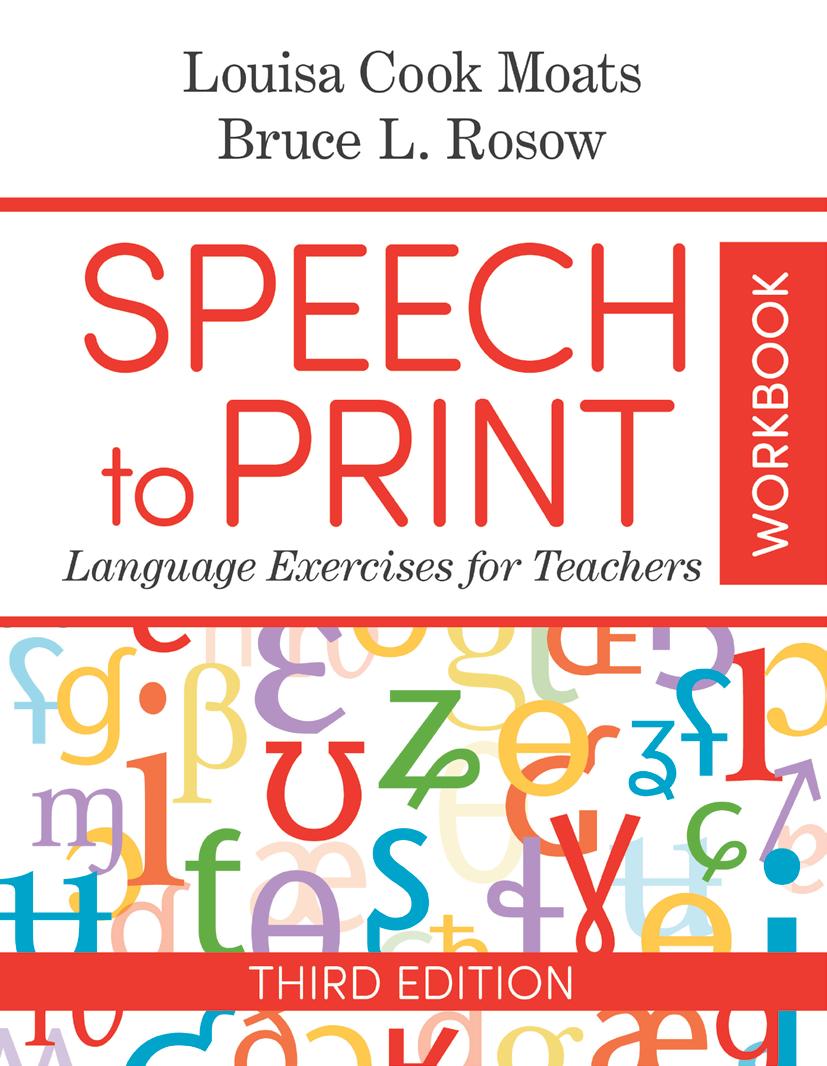
BOOK by Louisa Cook Moats, Ed.D. (Moats Associates Consulting, Inc.)
WORKBOOK by Louisa Cook Moats, Ed.D., & Bruce Lyons Rosow, Ed.D. (Windham Central Supervisory Union)
For two decades, the Speech to Print book and workbook have been bestselling resources on explicit, high-quality literacy instruction. Now the third editions are here, updated for today’s K–12 educators.
THE BOOK: Filling a critical gap in teacher preparation courses, Speech to Print supplies in-depth knowledge of the structure and function of language— fundamentals your students will need to deliver successful structured literacy instruction. Renowned literacy expert Louisa Cook Moats gives future teachers comprehensive and accessible information on the underpinnings of language instruction, plus case studies, activities, recommended teaching principles, and analysis of real-world student work samples.
WHAT’S NEW:
• New and expanded practical content on the how of language and reading instruction
• New and updated chapter exercises
• New faculty support materials, including chapter quizzes, a sample syllabus/course outline, PowerPoints, and PDF handouts for selected concepts
• More on key topics like program and curricula selection, frameworks for instructional planning, and problem solving when students are slow to respond to intervention
• More accessible, undergraduate-friendly tone and structure
THE WORKBOOK: The ideal companion to the third edition of the bestselling Speech to Print text, this workbook helps teachers practice their skills and prepare to deliver high-quality reading instruction.
WHAT’S NEW:

More than 30 new exercises not found in the Speech to Print textbook
Extensive new content and exercises addressing syntax and semantics

New chapter quizzes to reinforce teachers’ knowledge of language building blocks
Exercises that provide models and tips for teaching select concepts to students
A new final course exam
Book—US$44.95

Through a combination of subtests for students and surveys for teachers and parents, BESA reveals the big picture of a young bilingual child’s language develop ment. BESA includes:
3 subtests (in both English and Spanish) that address the key domains of morphosyntax, semantics, and phonology.
2 questionnaires: the Bilingual Input Output Survey (BIOS) and the Inventory to Assess Language Knowledge (ITALK)
Pragmatic activity used to establish rapport with the child and give clinicians an idea of how interactive the child will be during the assessment.
LEARN MORE: www.brookespublishing.com/besa
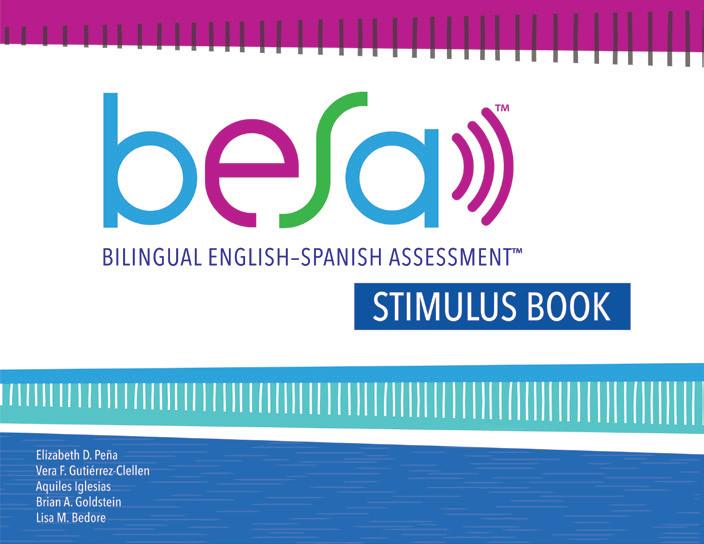
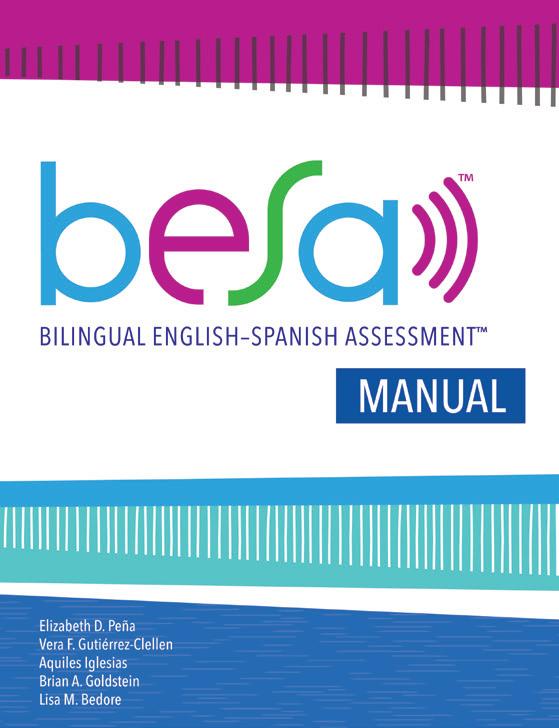
By Elizabeth D. Peña, Ph.D., CCC-SLP (University of California), Vera F. Gutiérrez-Clellen, Ph.D., CCC-SLP (San Diego State University), Aquiles Iglesias, Ph.D., CCC-SLP (University of Delaware), Brian A. Goldstein, Ph.D., CCC-SLP (La Salle University), & Lisa M. Bedore, Ph.D., CCC-SLP (Temple University)
—Sandra Barrueco, The Catholic University of America
When a young bilingual child experiences language difficulties, it can be hard to tell if those challenges are due to a disorder or just limited exposure to the English language. Introduce tomorrow’s clinicians to BESA: the valid, reliable assessment that specifically responds to the needs of young Spanish-English bilingual children. For use with children ages 4 through 6 years who have varying degrees of bilingualism, the Bilingual English–Spanish Assessment (BESA) was developed to
• Identify phonological and/or language impairment in bilingual children and English language learners using a standardized protocol
• Differentiate between a delay in English language acquisition and a true language disorder
• Document children’s speech and language strengths and needs
• Monitor children’s progress in both languages and use the information to make decisions about intervention
• Valid and reliable
• Culturally and linguistically appropriate
• Helps gauge progress in both languages
• Flexible and convenient—use each BESA component independently or combine them as part of an assessment battery

BESA KIT (Test Manual, stimulus book, protocols in English and Spanish, BIOS forms, and ITALK forms): INTRODUCTORY PRICE: $550.00 | Stock #: 52797 | 2018
Bilingual English–Spanish Assessment and BESA are trademarks of Paul H. Brookes Publishing Co., Inc.
“Measures like BESA are critically needed to compre hensively examine the language development of bilingual preschoolers.”

You can request exam/desk copies of up to two books that are relevant to your course needs. If you see a book in this catalog that you’re interested in previewing, please look it up on www.brookespublishing.com, click the Request Exam Copy button found on the book’s page, and complete the request form. (All requested informa tion must be supplied before we can process your order.)


